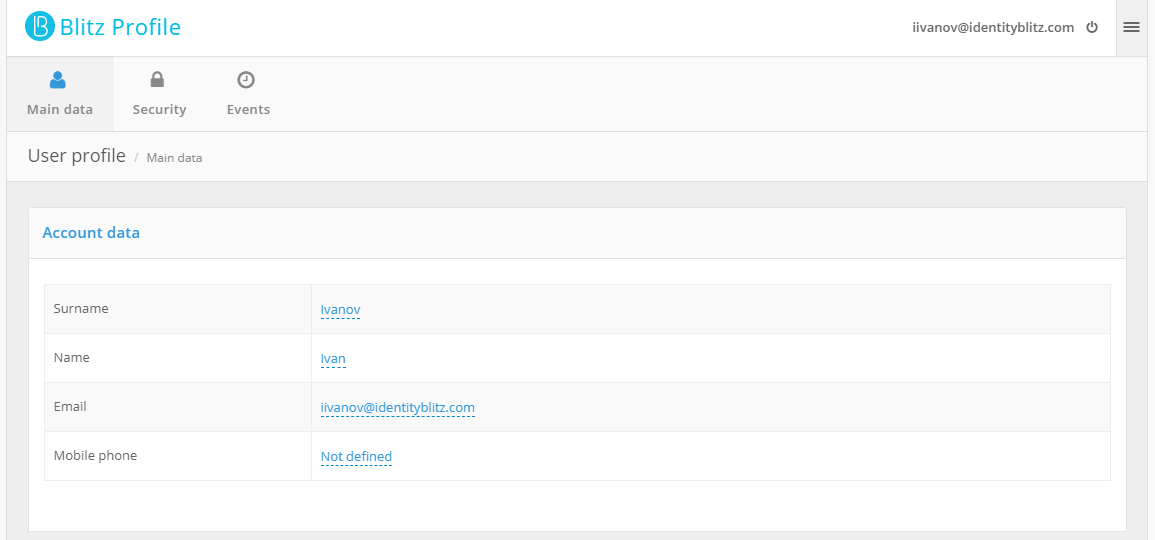User profile#
User profile is a web application in which the user can perform the following actions:
view or edit their account data;
view recent security events (e.g. login events);
change password;
view and configure the methods of login confirmation (two-factor authentication);
view and configure the security keys;
view bound social networking accounts; bind new external accounts; unbind unnecessary accounts;
view the bound access devices, and unbind unnecessary devices;
view and revoke data access permissions issued by applications;
view security events.
Configuration of User profile includes configuring the way user attributes are displayed and change additional parameters.
Displaying user attributes#
The main page of myAlpari displays a block with account data. An example of this block is shown in the figure below.

The display of user data is defined by an HTML template. The template is a text file that is compiled using the Twirl templating engine. In the template it is necessary to place functions that allow the user to enter and edit data about himself/herself in the User profile.
The following functions are available in the template:
@show(attrName)- displays the attribute value;@showStrings(attrName, values)- displays the array value;@editAsText(attrName, readableName, errorMsg)- displays the value of the attribute and allows you to edit it (the errorMsg parameter is optional);@editAsBoolean(attrName, readableName)- displays the value of the logical type (true/false) of the attribute and allows you to edit it;@editAsStrings(attrName, readableName, values)- displays the value (array) of the attribute and allows you to edit it.
These functions use the following parameters:
attrName– is the name of the attribute defined in the Data sources section;readableName- the name of the attribute, displayed to the user in the message (can be specified as attribute’s identifier from a message file or as a text);values- values, in formatkey - description, where key is array value, the description - the readable value of the key (for example,ListMap("a" -> "value a", "c" -> "value c")), can be set as an identifier from the message file or as a text;errorMsg- error description, which is displayed in case of erroneous value input (can be set as an identifier from a message file or as text). About message files see. Web interface texts. It is recommended to use message files if you need to support multilingualism.
Example of functions:
@editAsText("email", "Email")
@editAsText("phone_number", "Mobile phone", "Error")
@editAsBoolean("info", "Subscription")
@editAsStrings("massiv", "Subscriptions", ListMap("a" -> "Promotions and bonus programs", "b" -> "Company news", "c" -> "Monthly event digest"))
An example of displaying an array of strings in the interface of the User profile web application is shown in the figure:

Additional parameters#
The following parameters can be set as additional:
welcome template - information that is displayed in the upper right corner of myAlpari. It is allowed to use substitution strings. For example,
${family_name} ${given_name}will allow to display the surname and first name of the user;URL to follow after a successful logout from User profile;
period of audit events displayed to users (in calendar months from the current date);
template for displaying geodata in events (see Geodatabase). The template can be composed of the following elements containing country, region, city and coordinate information:
${ip_ctr}, ${ip_st}, ${ip_ct}, ${ip_lng}, ${ip_lat}, ${ip_rad}functions available to users, i.e. functions that can be activated by the user from the User profile. It is possible to enable or disable the following functions:
password change;
setting up a security question;
security key management;
view and binding of social networks;
view of access devices;
view and revoke permissions;
view events;
HOTP generators binding;
TOTP generators binding;
configuring login confirmation by SMS code;
configuring push authentication;
security key binding.
